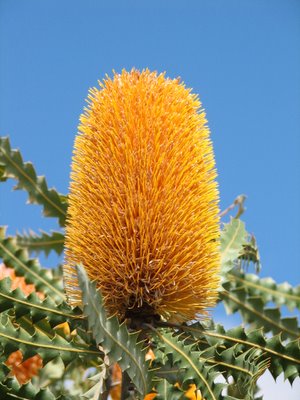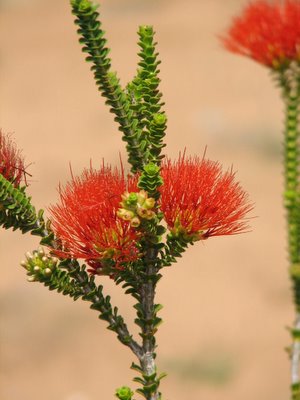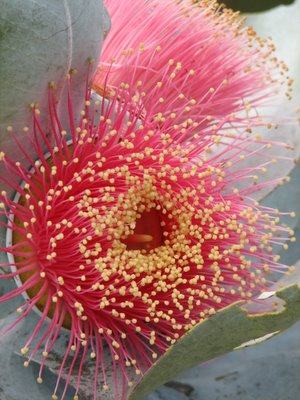Lorikeets, Parrots and Wattlebirds
This evening I was attracted by some birds calling outside. I went to investigate, thinking that they were probably Rainbow Lorikeets. I didn’t take my camera with me.
Sure enough, I had some good views of two Rainbow Lorikeets in the tree next to our driveway. The seeting sun was lighting up the brilliant colours of one of them. I needed my camera. It was still inside.
I casually walked inside trying not to scare the birds away by sudden movements. On emerging with the camera the lorikeets had disappeared – of course! Instead, I was content to get some very good shots of a Red Wattlebird in the setting sun in the same tree. It almost seemed like he was posing for me.
Perhaps the lorikeets had persuaded him to pose for them, because as I walked inside, they emerged from a nearby tree and flew a sortie overhead, screeching their taunts at me. One day, one day I’ll get a good shot of them.
Rainbow Lorikeets are quite common throughout the urban areas of Murray Bridge but we only occasionally see them on our home block on the outskirts of the city. In recent weeks they have been daily visitors. This indicates that there has to be enough plants flowering around here to attract these beautiful, but noisy, birds.
On this morning’s walk a had good views of two Elegant Parrots. This beautiful species is widespread in this area but they are not common anywhere. I also saw a single Adelaide Rosella. These are common in the Adelaide region and this is the eastern extent of their range and are uncommon in Murray Bridge. If I’d had my camera with me I would have been able to get an excellent photograph of a Rainbow Bee-eater sitting on a gate in the early morning sun.
Tomorrow.
Tomorrow – I’ll take my camera on my walk.
Lapwings Living Dangerously
On my way to a friend’s place this afternoon my car was “attacked” by an angry Masked Lapwing. I slowed right down to make sure I didn’t drive over it.
A few metres from the edge of the road was the reason for all the aggro. A tiny golf ball sized bit of fluff on legs was trying to cross the road. It made it successfully to the other side before another car came along. It too, was attacked by the very defensive parent.
This incident reminds me of a similar sighting over ten years ago. It was at possibly the busiest intersection in Adelaide. For those of you who know Adelaide it was the North Terrace, West Terrace, Port Road intersection. The very brave Masked Lapwing parents were trying desperately to keep their two little ones on the triangular grass medium strip. Trying to cross six or eight lanes of busy Saturday afternoon traffic would not have been a good career move. Of course, I was not able to witness what happened. I had to go with the flow of traffice and not sit there bird watching.
Pangarinda Arboretum, Wellington, South Australia

This morning we travelled down river through Tailem Bend to the small town of Wellington, South Australia. This town is near the end of the River Murray where it flows into Lake Alexandrina. From this lake it flows into the Coorong and out to the Southern Ocean.
Just east of the river at Wellington is the Pangarinda Arboretum. This consists of a plantation of Australian native plants established over a decade ago by local members of the Australian Plant Society (APS). The plantation has been planted in sections to represent different plant regimes from different parts of Australia.
Today’s gathering of members of APS was for a special Christmas lunch for members of the three local branches of APS. Members came from the Murray Bridge, Parrakie and Karoonda groups. Also present were members of the family of Ross Foreman who celebrates his 80th birthday tomorrow. Ross and his late wife Pat have been long time members of APS and they have freely given hundreds of volunteer hours of work to the arboretum. After cutting the birthday cake we all moved to another section of the plantation for Ross to open the Foreman Gazebo. This looks over the arboretum to the east and the river to the west.
After the ceremony we all wandered around the plantings looking at the many flowering plants. Some had finished their spring flowering but others, like the banksias, were resplendant in a variety of shapes and colours.
The bird watching was quite good too, with 22 species recorded, despite all the people wandering around. I managed to get some very good flower shots and one good photograph of a thornbill. The following is a list of the birds seen:
White Faced Heron
Pacific Black Duck
Nankeen Kestral
Swamp Harrier
Black Kite
White Ibis
Rock Dove
Peaceful Dove
Crested Pigeon
Galah
Elegant Parrot
Singing Honeyeater
New Holland Honeyeater
Magie Lark
Australian Magpie
Yellow Rumped Thornbill
Common Starling
House Sparrow
Common Blackbird
European Goldfinch
Willie Wagtail
One of the members who regularly does volunteer work there reported to me that Zebra Finches had been breeding in the plantation recently.
Morning Walk
I went for an hour long walk early this morning. I hadn’t intended making a list of birds I saw and heard but the birding was so good this morning that I recorded a list of all the species seen and heard.
For my regular walks I have five different routes. Two of the walks have been added only in the last eighteen months. Three of the routes I have used regularly for many years. I have bird lists for some of these walks over the last 17 years and this information is entered on a birding database.
The highlight of the walk this morning was to see four Varied Sittellas. This species is widespread in this area but they are not common anywhere. I have recorded them on only a few occasions. Unfortunately I didn’t have my camera with me so I cannot show a picture of one. They behave a little like treecreepers, clinging to the tree branches in all kinds of positions. More experienced ornithologists than me have been quite perplexed as to how these delightful little birds seem to be able to hop underneath a branch – and not fall off. They seem to defy gravity!
Another highlight this morning was to hear several Peaceful Doves. Their soft coo-cooing has an almost ventriloquial quality; it can seem to be coming from a hundred metres away but the bird is actually sitting in the tree above you! I did get a photograph of a Peaceful dove several days ago but it was in too much shadow to see it clearly.
Both of these species are occasional visitors to our garden. It is always a delight to hear and see them so close to our home.
My first Blog entry
I am a first time Blogger. This is my very first entry having successfully stepped through the setup process.
I am reasonably familiar with the world of blogging because I regularly read the blogs of my daughter Rose in England and son Simon in Sydney (when he’s home), mainly to keep up with what they are doing and where in the world they are!
I plan to include recent interesting sightings of birds in and around our garden and property on the fringe of the rural city of Murray Bridge in South Australia. Our home is situated on 5 acres (2 hectares) of land. We have about two acres of mallee scrub and have planted several thousand trees and small plants on the rest.
I will also include reports on any trips I take here in South Australia and in other parts of Australia – and overseas when that happens. I also plan to include photos of birds (and other interesting things) taken with my new digital camera, a Canon Powershot S2 IS. The 12x zoom facility is great for birds shots. (Update: I updated my camera in 2011 to a Canon Powershot SX20 with a 20x zoom. Photos from the latter part of 2011 were taken with the new camera.)
It has been raining steadily here all morning so we are confined to the indoors. The bird life has been very quiet during the rain, but when I went to check the rain gauge a few minutes ago I observed five rather wet Crested Pigeons on a nearby power line. Sometimes I have observed up to 30 or 40 of these beautiful birds all perched on the power lines that run along the side of our property. Above is a photo of a Crested Pigeon taken yesterday. It was quietly sunning itself near the house. I was able to sneak up to within about 4 metres from it.
Yesterday I also managed to get a good photo of a male Mistletoe Bird. These delightful little birds are quite common around here and are frequent visitors to our garden. About 15 years ago this was the first species I recorded nesting in a plant we had planted on this property.
This post was updated on 2nd September 2015.
Good birding.
Trevor






